RESEARCH
Food security in South Africa: a review of national surveys
Sécurité alimentaire en Afrique du Sud: un examen des enquêtes nationales
Seguridad alimentaria en Sudáfrica: revisión de las encuestas nacionales
Demetre LabadariosI; Zandile June-Rose MchizaI,*; Nelia Patricia SteynI; Gerda GerickeII; Eleni Maria Winifred MaunderIII; Yul Derek DavidsI; Whadi-ah ParkerI
IPopulation Health, Health Systems and Innovation, Human Science Research Council, 12th Floor Plein Park Building, 6983 Plein Street, Cape Town, 8001, South Africa
IIDepartment of Human Nutrition, University of Pretoria, Pretoria, South Africa
IIIBournemouth University, Bournemouth, England
ABSTRACT
OBJECTIVE: To assess the status of food security i.e. access to food, food availability and food utilization in South Africa.
METHODS: A systematic search of national surveys that used the Community Childhood Hunger Identification Project (CCHIP) index to measure food security in South Africa over a period of 10 years (19992008) was conducted. Anthropometric data for children aged 19 years were used to assess food utilization, and household food inventory data were used to assess food availability.
FINDINGS: Only three national surveys had used the CCHIP index, namely, the 1999 and 2005 National Food Consumption Surveys (NFCS) and the 2008 South African Social Attitudes Survey. These surveys showed a relatively large decrease in food insecurity between 1999 and 2008. However, the consistent emerging trend indicated that in poorer households women were either feeding their children a poor diet or skipping meals so their children could eat. In terms of food access and availability, the 1999 NFCS showed that households that enjoyed food security consumed an average of 16 different food items over 24 hours, whereas poorer households spent less money on food and consumed fewer than 8 different food items. Moreover, children had low mean scores for dietary diversity (3.58; standard deviation, SD: ± 1.37) and dietary variety (5.52; SD: ± 2.54) scores. In terms of food utilization, the NFCS showed that stunting in children decreased from 21.6% in 1999 to 18% in 2005.
CONCLUSION: The South African government must implement measures to improve the undesirably high level of food insecurity in poorer households.
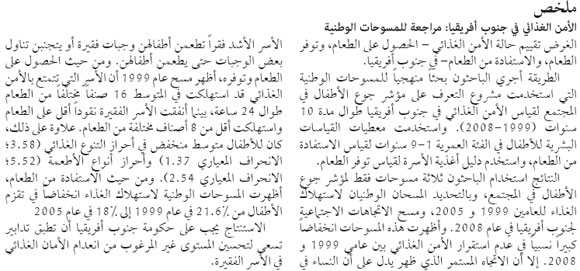

RÉSUMÉ
OBJECTIF: Évaluer l'état de la sécurité alimentaire - à savoir l'accès aux aliments, leur disponibilité et leur utilisation, en Afrique du Sud.
MÉTHODES: Examen systématique des enquêtes nationales utilisant l'indice du Projet communautaire d'identification de la faim chez l'enfant (CCHIP) a été effectué pour évaluer la sécurité alimentaire en Afrique du Sud sur une période de 10 ans (1999 à 2008). Des données anthropométriques pour des enfants âgés de 1 à 9 ans ont été utilisées pour évaluer l'utilisation des aliments, et des données d'inventaire relatives aux aliments des ménages ont été utilisées pour évaluer les disponibilités alimentaires.
RÉSULTANTS: Seules trois enquêtes nationales ont utilisé l'indice CCHIP, à savoir l'Enquête nationale sur la consommation alimentaire (NFCS) de 1999 et 2005, et l'Enquête sur les attitudes sociales sud-africaines de 2008. Ces enquêtes ont montré une diminution relativement importante de l'insécurité alimentaire entre 1999 et 2008. Cependant, la tendance qui se dégageait de manière constante, indiquait que, dans les ménages plus pauvres, les femmes donnaient une alimentation pauvre à leurs enfants ou qu'elles sautaient des repas pour que leurs enfants puissent manger. En termes d'accès aux aliments et de disponibilité de ceux-ci, l'enquête NFCS de 1999 a montré que les ménages jouissant d'une sécurité alimentaire consommaient une moyenne de 16 aliments différents sur une période de 24 heures, tandis que les ménages plus pauvres consacraient moins d'argent aux aliments et consommaient moins de 8 aliments différents. Par ailleurs, les enfants avaient de faibles scores moyens pour la diversité alimentaire (3,58; écart-type: ± 1,37) et pour la variété diététique (5,52; écart-type: ± 2,54). En termes d'utilisation d'aliments, le NFCS a montré que le retard de croissance des enfants avait diminué de 21,6% en 1999 à 18% en 2005.
CONCLUSION: Le gouvernement sud-africain doit mettre en uvre des mesures pour réduire le niveau d'insécurité alimentaire excessivement élevé des ménages les plus pauvres.
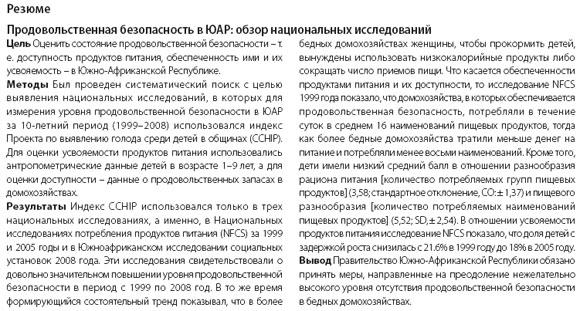
RESUMEN
OBJETIVO : Evaluar el estado de la seguridad alimentaria (acceso a los alimentos, disponibilidad de los alimentos y utilización de los mismos) en Sudáfrica.
MÉTODOS: Se realizó una búsqueda sistemática de encuestas nacionales que emplearan el índice del Proyecto de Identificación de Desnutrición Infantil en la Comunidad (CCHIP, por sus siglas en inglés) para medir la seguridad alimentaria en Sudáfrica durante un periodo de 10 años (entre 1999 y 2008). Se emplearon los datos antropométricos de niños con edades comprendidas entre los 1 y los 9 años para evaluar la utilización de los alimentos y se utilizaron los datos del inventario doméstico de alimentos para valorar la disponibilidad de alimentos.
RESULTADOS: Solo tres encuestas nacionales emplearon el índice CCHIP, concretamente, las Encuestas Nacionales de Consumo de Alimentos (NFCS, por sus siglas en inglés) de 1999 y 2005 y la Encuesta de Actitudes Sociales de Sudáfrica del año 2008. Estas encuestas muestran un descenso relativamente significativo en la inseguridad alimentaria entre los años 1999 y 2008. No obstante, una tendencia emergente y constante reveló que en los hogares más pobres, las mujeres suministraban a sus hijos una dieta pobre o se saltaban comidas para que sus hijos pudieran comer. En lo relativo al acceso a los alimentos y a la disponibilidad de los mismos, la encuesta NFCS de 1999 mostró que los hogares que disfrutaban de una mayor seguridad alimentaria consumían una media de 16 alimentos distintos a lo largo de 24 horas, mientras que las familias más pobres gastaban menos dinero en comida y consumían menos de 8 alimentos distintos. Además, los niños registraron una baja puntuación media en cuanto a diversidad en su dieta (3,58; desviación estándar, DE: ± 1,37) y en cuanto a variedad en su dieta (5,52; DE, ± 2,54). En cuanto a la utilización de los alimentos, la NFCS registró un descenso en el retraso del crecimiento infantil, desde un 21,6% en 1999 hasta un 18% en el año 2005.
CONCLUSIÓN: El Gobierno sudafricano debe implementar medidas que mejoren esos niveles elevados de inseguridad alimentaria en los hogares que dispongan de menos recursos.
Introduction
Food insecurity has emerged as a global crisis following the global economic meltdown.1 According to the 2004 report of the Food and Agriculture Organization (FAO) on the state of food insecurity in the world, more than 814 million people in developing countries are undernourished.2 Of these people, 204 million live in countries of sub-Saharan Africa, including South Africa.
Despite the political and economic advances seen in South Africa since 1994, the country is plagued by poverty and unemployment and, following the recent global economic crisis, by steep food and fuel prices, high-energy tariffs and increasing interest rates.3 These adverse conditions have placed severe pressure on ordinary South Africans already struggling to meet their basic household needs. Thus, a proper definition of the term "food insecurity" and measures that are suitable for the South African context must be urgently developed.
Food security is said to exist, in accordance with its international definition, when in a society all people at all times have enough food for an active, healthy life.4 Food security as an umbrella term includes: (i) the availability of food that is nutritious and safe; (ii) an assured ability to procure and acquire food of good quality in a socially acceptable way (e.g. without resorting to emergency food supplies, scavenging, stealing or similar coping strategies). In contrast, food insecurity exists when food is not easily accessible and households have difficulty securing adequate food.
In recent years particular attention has been paid to access to food and its measurement. This stems from the realization that even when food is available in markets, it may not be accessible to specific households.4 According to Davids,5 after 10 years of democracy a large proportion of South Africans still perceive themselves as lacking enough income to meet all their household needs. "Access" has been defined as a household's ability to acquire enough food of sufficient quality to have all of its members meet their nutritional requirements and lead productive lives.
Millions of dollars are spent annually on food aid programmes intended to alleviate hunger and poverty. For these programmes to work effectively, households at greatest risk of food insecurity have to be identified by means of an objective and accurate indicator of food access and food availability at the household level. The Community Childhood Hunger Identification Project (CCHIP) index, the household dietary diversity score and the food variety score are among the measures developed for this purpose in the United States of America.710 The CCHIP index defines hunger as the mental and physical condition arising from not eating enough food because of insufficient economic resources within the family or community. In contrast, the household dietary diversity score and the food variety score measure the average number of food groups or items consumed within a household over a period of 24 hours: from a total of 12 possible food groups and of 45 possible items, respectively.
No national survey has been conducted to assess all the dimensions of food insecurity in South Africa, although some national surveys have included specific components of food insecurity. Thus, the objective of the current study was to review the food insecurity components of these surveys and establish whether they covered food access, food utilization and food availability. Food access can be measured both in terms of the hunger experienced by individuals within a household or of the household's dietary diversity. Conversely, food utilization can be measured using anthropometric parameters (height and weight), dietary intake or blood nutrient levels. Lastly, food availability can be measured using household food inventory and/or food procurement data.
Methods
We conducted a search of electronic databases for national surveys carried out between January 1999 and December 2009 in which the CCHIP index was used to establish the state of food insecurity in South Africa.
Search strategy
The databases searched were MEDLINE (PubMed), EMBASE and the Cochrane library and reviews. To make sure that we retrieved all surveys, we used keywords such as "food insecurity", "food security" and "South Africa", selected in accordance with the National Library of Medicine's Medical Subject Headings. We then refined the search by including keywords for the time frame (i.e. January 1999 to December 2009) (Box 1). Only one investigator assessed the search results. After an initial thorough and systematic search, one investigator (the subject expert) double-checked the surveys to ensure that they met the inclusion criteria. The same investigator also checked the completeness of the results and determined whether the original CCHIP index developed by Swindale and Bilinsky7 had been used to measure food security in the surveys included.
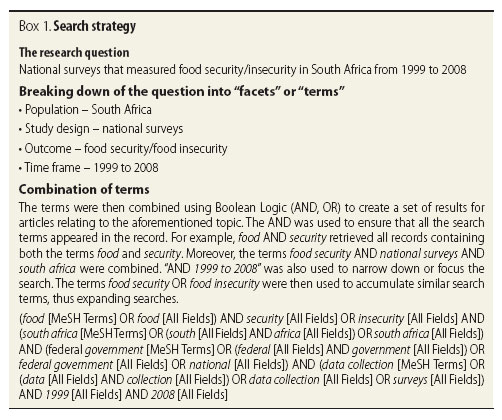
Only three national surveys that used the CCHIP index to assess the level of food insecurity in South Africa namely, the 1999 National Food Consumption Survey (NFCS),11 the 2005 National Food Consumption Survey Fortification Baseline I (NFCS:FB-I),12 and the 2008 South African Social Attitudes Survey (SASAS)13 were included. Their primary investigators were contacted to request consent to conduct secondary analyses of their data. The 1999 NFCS, which included children only, provided data on all aspects of food insecurity mentioned previously, as did the 2005 NFCS:FB-I, which included women and children. However, the SASAS, an annual survey conducted by the Human Sciences Research Council, provided data on hunger alone.
Population size
The 1999 NFCS and the 2005 NFCS:FB-I were conducted on South African households (2894 and 2469, respectively) with children aged 1 to 9 years. Both surveys assessed food procurement, anthropometric parameters and hunger, and both inventoried the foods in the households (all foods in 1999 and 2005; as well as fortified foods in addition to non-fortified foods in 2005). The SASAS, which measures the attitudes of individuals towards democracy, governance, poverty and social identity issues, was expanded in 2008 to include the measurement of hunger. The 2008 SASAS survey interviewed randomly selected adults (16 years of age and older) from randomly selected households. These adults were not necessarily the caregivers of the children in the households. Thus, to be able to compare the 2008 SASAS data (n = 3500) with the data from the 1999 NFCS and the 2005 NFCS:FB-I, we limited our secondary analysis to data from the SASAS survey to those households with children aged 1 to 9 years (n = 1150).
Sampling frame
The population sample in the 1999 NFCS was selected based on the 1996 census sampling frame, whereas, the 2005 NFCS and SASAS were selected based on the 2001 census sampling frame, both provided by Statistics South Africa.1
Survey instrument
All three surveys measured hunger using the CCHIP index,7 which has been validated in the South African context.1113 The CCHIP index (Box 2) is composed of eight questions that investigate food insecurity at three levels: the household (question 12), the adult (question 34) and the child (questions 58). It also assesses food shortages, perceived food insufficiency or changes in food intake resulting from resource constraints. Furthermore, for each aspect of hunger (i.e. for all eight questions), two further questions explore the extent of the food insecurity over a period of 30 days.

Regional survey
We also included in the analysis relevant data from the 2005 Food Insecurity and Vulnerability Information and Mapping Systems (FIVIMS), which covered 597 households in Sekhukhune.15 Although this survey was not national in scope, it was included because it measured hunger in some rural South African provinces (Mpumalanga and Limpopo). Also, it used an adapted version of the CCHIP index and hence afforded a good comparison with the 2005 NFCS. However, only two questions (1 and 8) were exactly the same in the original and the adapted versions of the CCHIP index (Box 2).
Data analyses
We performed secondary analyses of the data from the four surveys. Details of data analyses for the individual surveys are presented in the primary studies.1113,15 In brief, SAS 845 (SAS Institute, Cary, USA) was used to analyse the data from the NFCS and the NFCS:FB-I, and SPSS-SA (SPSS Inc., Chicago, USA) to analyse the data from the SASAS and FIVIMS.
We assessed food insecurity over the period from 1999 to 2008, as reflected in access to food, by comparing CCHIP index data from the four existing databases. The level of food insecurity was given by the number of affirmative responses on the CCHIP index. For example, respondents who answered "yes" to up to four questions were classified as being at risk of food insecurity, whereas those who answered "yes" to five questions or more were classified as experiencing food insecurity. Conversely, those who responded "no" to all eight questions were considered to be free from food insecurity.
Data on access to food (presented as nutrient adequacy as well as dietary diversity and variety) is expressed as means and their standard deviations. The prevalence of food insecurity (at the national, province, household, question and questionnaire item level) is expressed as percentages. Data on food utilization (presented as anthropometric z-scores) is expressed as percentages. Food availability is expressed as the number of food items in the household inventory.
Results
Table 1 compares the results of the CCHIP index observed in the three national surveys. Food insecurity clearly decreased in South Africa at both the household and the individual level from 1999 to 2008. The results of the 2005 FIVIMS study were similar to those observed in the NFCS:FB-I conducted the same year.
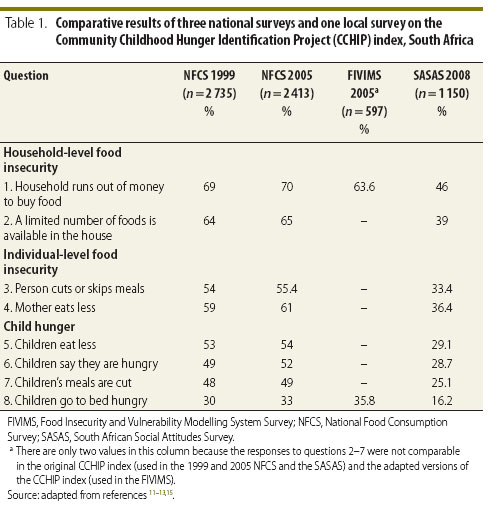
Food insecurity
Table 2 summarizes the results of the three national surveys in terms of the proportion of people who were free from, at risk of and experiencing food insecurity. Overall, between 1999 and 2008 the prevalence of food insecurity in South Africa appears to have been reduced by more than half, from 52.3% to 25.9%. However, the proportion of people at risk of experiencing food insecurity remained practically unchanged. The reduction was noted in both urban and rural areas, where food insecurity decreased from 42.0% to 20.5% and from 62.0% to 33.1%, respectively (Fig. 1). Among the provinces, the Eastern Cape had the highest prevalence of food insecurity in 1999 (83.0%), followed by the Northern Cape (63.0%), Limpopo (55.0%) and the North West province (62.0%), all of which are rural. By 2008, the prevalence of food insecurity had decreased in all provinces, although the Eastern Cape still had the highest prevalence (45.4%). On the other hand, food insecurity in the Northern Cape had decreased dramatically, from 63% to 14.2% (Fig. 2).
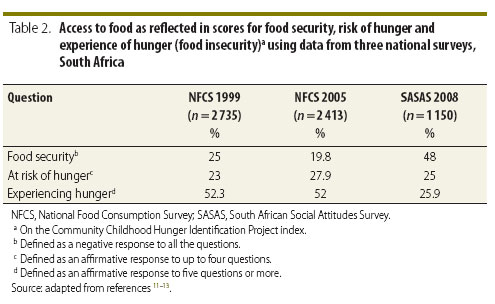
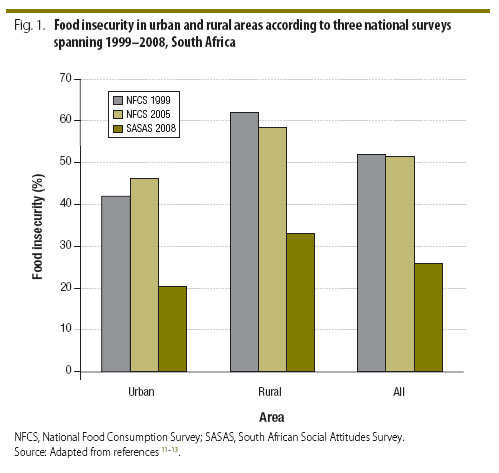
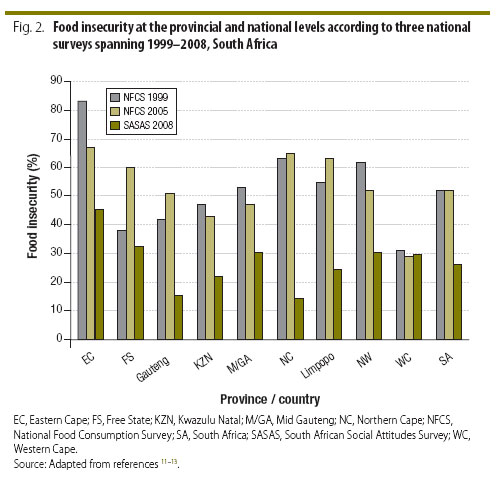
Access to food
Table 3 presents data on nutrient adequacy, food variety and dietary diversity scores from the 1999 NFCS. The results clearly show that more than one third of the children in all age groups scored very low in terms of food diversity (mean score: 3.58; standard deviation, SD: ± 1.37) and food variety (mean score: 5.52; SD: ± 2.54).
Food utilization
The anthropometric status (expressed as z-scores) of children aged 19 years in the NFCS surveys was used as a proxy measure for food utilization. Fig. 3 shows that stunting is still a very common condition in South Africa. In 2005, 18.0% of the children were chronically undernourished (stunted).
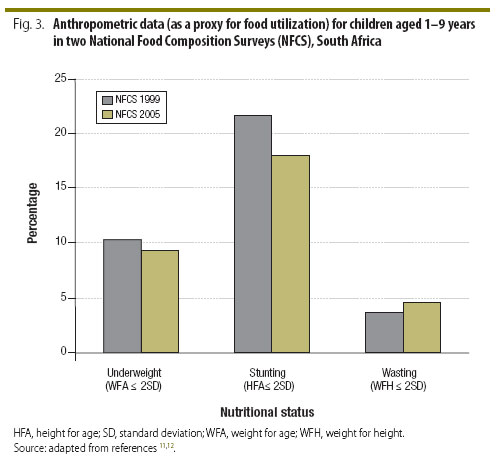
Fig. 4 shows that the dietary diversity score was positively related with z-scores for underweight, stunting and wasting among children included in the 1999 NFCS. Height for age and weight for age were more than zero standard deviations above the mean only when the dietary diversity score was 6 or above. A similar trend was seen in nutrient adequacy ratios, which reached 100% only when the dietary diversity score was 5 or above. Nutrient adequacy ratios were generated by dividing the children's intake of each of 11 micronutrients (vitamins A, B6, B12 and C, niacin, thiamin, riboflavin, folate, calcium, iron and zinc) by the recommended intake for that nutrient using the intakes for gender and age recommended by the World Health Organization and FAO, and then multiplying the total by 100.
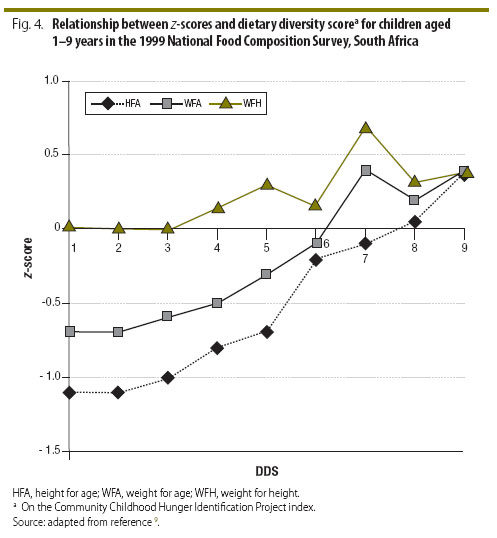
Food availability
Fig. 5 presents household food availability data for the 1999 NFCS. Notably, all formal urban households and households with a higher income (> 12 000 rand (R), or > US$ 1522 per annum) had more food items in the household inventory (an average of 15.7 different ones) than rural households and households with lower income (= R12 000, or = US$ 1522 per annum), which averaged 7.4 different food items. Statistics South Africa classifies urban areas according to predominant settlement type and land use. Cities, towns, townships and suburbs are typical formal urban settlements. Informal settlements (squatter camps and shacks), hostels, institutions, industrial and recreational areas, and small holdings within or adjacent to any formal urban areas are also classified as urban. Any area that is not classified as urban, including tribal areas and commercial farms, is classified as rural.1
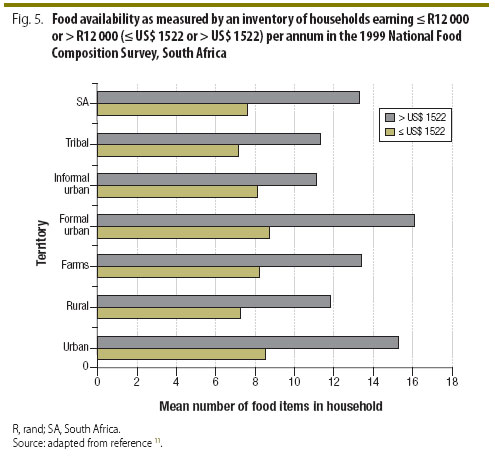
Food availability also differed across provinces. In all provinces other than the Western Cape food variety was lower in poorer and rural households than in higher-income and urban households (average of 5 versus 14 different food items, respectively). The Western Cape recorded the greatest food variety (average of 15 food items) across households of all income levels and both rural and urban (data not shown).
Discussion
Food insecurity constitutes a global crisis. This explains why eradicating extreme poverty and hunger is the first Millennium Development Goal. In this light, the results presented in this paper, which point to a reduction in the prevalence of food insecurity in South Africa between 1999 and 2008, are extremely encouraging.
What, then, are the country-specific factors that have contributed to this decrease? One of them could be the explicit recognition in the current South African constitution that the right to food comes under the Bill of Rights, along with several others with which it is related.16 As such, several government policies designed to address food insecurity have been put into effect and enforced.17 These policies have led to food fortification, food supplementation, school feeding programmes and day care centre schemes.
The National School Nutrition Programme (NSNP) aims to foster better quality education by enhancing children's active learning capacity; alleviating short-term hunger; providing an incentive for children to attend school, regularly and punctually; and addressing certain micro-nutrient deficiencies.18 Since 1999, the government has allocated more than R450 million (US$ 58 million) to the NSNP,18 and nongovernmental organizations have contributed concurrently to this programme. For instance, in the Western Cape, the Peninsula NSNP fed about 64 392 children in 368 primary schools in 2001.18 By 2009, the number had increased to at least 200 000.17 Although this is encouraging, some schools, especially in rural areas, have not yet been reached. Infrastructural factors such as poor roads or transportation to these schools may be among the barriers.1
Another government initiative that targets food insecurity is social grants. These come in the form of old age pension funds, disability grants, foster care grants, care dependency grants and child support grants.17 All of these have been shown to increase women's purchasing power as well as their access to food.17 In the period from 1999 to 2003, approximately 2.6 million South Africans received social grants and by 2007 this figure had increased to 12 million.17 Despite this remarkable achievement, not all South Africans who qualify for these grants are managing to access them. One reason may be that social welfare officials in different provinces are not consistent in observing the set national criteria for determining who is eligible for these grants. Intra-departmental corruption within the social welfare system and stringent guidelines for selecting those who qualify for grants are among several factors that keep the grants from reaching all poor South Africans.192
Tradition and agricultural practices heavily influence the type of diet consumed by South Africans. However, this study highlights income and access to food as the most important determinants of food availability. Indeed, the majority of South African households still struggle to sustain a decent income; the estimated average income of the poor is less than R1000 (US$ 127) every month.11 As a result, the women residing in these households find it very difficult to purchase enough food to feed the entire household. According to Bonti-Ankomah,22 the average South African adult requires a minimum of ± R9.55 (± US$ 1.22) every day or ± R286.5 (± US$ 36.38) each month (depending on inflation) to procure a healthy balanced diet. The average household in South Africa has four members23,24 and requires around R38.20 (US$ 4.85) every day or R1146 (US$ 145.54) every month to procure a healthy diet for all of them. Lehohla25 has suggested that the situation may be even worse since poorer South African households tend to have six or seven members. Moreover, the average of eight food items stocked in the cupboards of poorer households according to the 1999 NFCS household inventory data is substantially below the minimum requirement of 17 items needed to maintain a healthy, well balanced diet according to Bonti-Ankomah.2
Our findings show that the nutrient density of the diet consumed by South African children is insufficient to meet their nutrient requirements. Similarly, they have shown alarmingly low food variety and household dietary diversity scores, both of which have been positively related to children's nutritional status.9 Despite evidence that food fortification programmes have improved the micronutrient status of South African children,26 they have failed to improve dietary diversity and overall macronutrient intake. Hence, stunting still affects a large proportion of children.11 Deficits in macronutrient intake and poor dietary diversity could conceivably be addressed by means of strategies not dependent on income, such as the promotion of subsistence farming and efforts to increase awareness of the nutrient content of indigenous fruits and vegetables.26 However, the majority of the South African population lacks land for growing its own food and will have to continue to purchase food items commercially.2
This study has several limitations. First, although the CCHIP was assessed for content and face validity,13 the item analysis to ensure each question's validity was not performed before any of the South African studies. Second, the surveys followed somewhat different sampling criteria. The 1999 and 2005 NFCS included only child caregivers (2894 and 2469 women 18 years of age and older, respectively), whereas the SASAS included 1150 people, male or female, who were not necessarily the children's caregivers. Finally, the three surveys were conducted at different times of the year the two NFCS surveys between January and April, and the SASAS between August and October and this may have influenced the responses given by the participants on food availability and the food stocked in the households.
In summary, food insecurity has decreased in South Africa over the past 10 years. However, a substantial proportion of households remains at risk of hunger or is experiencing hunger. Although the measures and programmes initiated by the South African government appear to be beneficial, they need to be run more effectively to further alleviate food insecurity.28 Moreover, the lack of access to land for the South African majority must be addressed through sustainable, non-income-dependent measures, such as the promotion of subsistence farming.28
Funding: The Human Science Research Council of South Africa provided financial support for this study.
Competing interests: None declared.
References
1. Global food insecurity and price increase (Situation Report # 1, Fiscal Year 2009). New York: United States Agency for International Development, Bureau for Democracy, Conflict, and Humanitarian Assistance, Office of US Foreign Disaster Assistance; 2009. Available from: http://www.usaid.gov/our_work/humanitarian_assistance/foodcrisis/documents/052209_foodcrisis_sr1.pdf [accessed 16 September 2011] .
2. The state of food insecurity in the world 2004: monitoring progress towards the World Food Summit and Millennium Development Goals. Rome: Food and Agriculture Organization; 2004. Available from: ftp://ftp.fao.org/DOCREP/FAO/007/Y5650E/Y5650E00.PDF [accessed 13 September 2011] .
3. Economic and Social Council [Internet]. Economic and Social Council briefed by top UN officials on work of Global Food Crisis Task Force: outcome of November World Summit on Food Security. New York: United Nations; 2009. Available from: http://www.un.org/News/Press/docs/2009/ecosoc6401.doc.htm [accessed 21 September 2011] .
4. United States Department of Agriculture. Economic Research Service [Internet]. Food security in the United States: definitions of hunger and food security. Washington: USDA; 2011. Available from: http://www.ers.usda.gov/Briefing/FoodSecurity/labels.htm [accessed 16 September 2011] .
5. Davids YD. Poverty in South Africa: extent of access to food and income. HSRC Rev 2006;4:167.
6. Webb P, Coates J, Frongillo EA, Rogers BL, Swindale A, Bilinsky P. Measuring household food insecurity: why it's so important and yet so difficult to do. J Nutr 2006;136:1404S8S. PMID:16614437
7. Swindale A, Bilinsky P. Development of a universally applicable household food insecurity measurement tool: process, current status, and outstanding issues. J Nutr 2006. a136:1449S52S. PMID:16614442
8. Swindale A, Bilinsky P. Household Dietary Diversity Score (HDDS) for measurement of household food access: indicator guide, version 2. Washington: United States Agency for International Development; 2006; Available from: http://www.fantaproject.org/downloads/pdfs/HDDS_v2_Sep06.pdf [accessed 16 September 2011] .
9. Steyn NP, Nel JH, Nantel G, Kennedy G, Labadarios D. Food variety and dietary diversity scores in children: are they good indicators of dietary adequacy? Public Health Nutr 2006;9:64450. doi:10.1079/PHN2005912 PMID:16923296
10. Kaaks R, Riboli E, Estève J, van Kappel AL, van Staveren WA. Estimating the accuracy of dietary questionnaire assessments: validation in terms of structural equation models. Stat Med 1994;13:12742. doi:10.1002/sim.4780130204 PMID:8122049
11. Labadarios D, editor. The National Food Consumption Survey (NFCS): children aged 19 years, South Africa, 1999. Stellenbosch; Directorate: Nutrition, Department of Health, National Food Consumption Survey Consortium; 2000.
12. Labadarios D, Swart R, Maunder EMW, Kruger HS, Gericke GJ, Kuzwayo PMN et al. Executive summary of the National Food Consumption Survey Fortification Baseline (NFCS-FB-I) SA, 2005. SA J Clin Nutr 2008;21(Suppl. 2):247300.
13. South African Social Attitudes Survey (SASAS). Pretoria: Human Sciences Research Council; 2008. Available from: www.hsrc.ac.za [accessed 16 September 2011] .
14. Statistics South Africa Census 2001 [Internet]. Concepts and definitions for Statistics South Africa (Report No. 03-02-26, version 2). Pretoria: SSA. Available from: http://www.statssa.gov.za/inside_statssa/standardisation_concepts_definitions.asp [accessed 16 September 2011] .
15. National FIVIMS launched in the Republic of South Africa. Rome: Food and Agriculture Organization; 2005. Available from: http://www.fivims.org/index2.php?option=com_content&do_pdf=1&id=131 [accessed 21 September 2011] .
16. Gordhan P. Speech by Finance Minister Pravin Gordhan on the State of the Nation, 5 June 2009. Pretoria: Ministry of Finance; 2009. Available from: http://www.treasury.gov.za/comm_media/speeches/2009/2009060501.pdf [accessed 16 September 2011] .
17. Netshitenzhe J. Development indicator mid-term review. Pretoria: The Presidency, Republic of South Africa; 2007. Available from: http://www.info.gov.za/otherdocs/2007/development_indicators.pdf [accessed 16 September 2011] .
18. Kallman K. Food for thought: a review of the National School Nutrition Programme. Cape Town: University of Cape Town; 2005. Available from: http://www.ci.org.za/depts/ci/pubs/pdf/poverty/facts/Foodforthought.pdf [accessed 21 September 2011] .
19. Goldblatt B, Rosa S, Hall K. Implementation of the child support grant. Cape Town: University of the Witwatersrand and the Children's Institute, University of Cape Town; 2006. Available from: http://www.sarpn.org.za/documents/d0001950/index.php [accessed 16 September 2011] .
20. van der Westhuizen C, van Zyll A. Obstacles to the delivery of social security grants? (Budget Brief No. 110). Pretoria: Idasa, an African Democracy Institute; 2002. Available from: http://www.idasa.org/media/uploads/outputs/files/Budget%20Brief%20110%20.pdf [accessed 16 September 2011] .
21. Case A, Hosegood V, Lund F. The reach of the South African child support grant: evidence from KwaZulu-Natal (Working Paper No. 38). Durban: University of Kwazulu-Natal, School of Development Studies; 2003. Available from: http://www.sarpn.org/documents/d0000582/P538_Child_Support_KZN.pdf [accessed 16 September 2011] .
22. Bonti-Ankomah S. Addressing food insecurity in South Africa. Pretoria: The National Institute for Economic Policy; 2001. Available from: http://www.sarpn.org.za/EventPapers/Land/20010605Bonti.pdf [accessed 16 September 2011] .
23. Pirouz F. Have labour market outcomes affected household structure in South Africa? A descriptive analysis of households. Cape Town: University of Cape Town, School of Development Policy Research Unit and Economic and Business Science, University of Witwatersrand; 2005. Available from: http://www.tips.org.za/files/Labour_market_outcomes_FarahPirouz.pdf [accessed 16 September 2011] .
24. Post-enumeration survey: results and methodology. Pretoria: Statistics South Africa, Census 2001; 2004. Available from: http://www.statssa.gov.za/census01/HTML/pes.pdf [accessed 23 September 2011] .
25. Lehohla P. Post-enumeration survey: results and methodology. Statistics SA Census 2001. 2004. Available at: http://www.statssa.gov.za/census01/HTML/pes.pdf [accessed 21 January 2010] .
26. Steyn NP, Temple N, editors. Community nutrition textbook for South Africa: a rights-based approach. Parow: Medical Research Council; 2008.
27. Van Zyl J, Kirsten J, Binswanger HP, editors. Agricultural land reform in South Africa: policies, markets and mechanisms. Cape Town: Cape Town University Press; 1996.
28. Aliber M, Hart TGB. Should subsistence agriculture be supported as a strategy to address rural food insecurity? Agrekon 2009;48:43458. doi:10.1080/03031853.2009.9523835
Submitted: 13 April 2011
Revised version received: 11 August 2011
Accepted: 23 August 2011
Published online: 4 October 2011
* Correspondence to Zandile June-Rose Mchiza (e-mail: zmchiza@hsrc.ac.za).
